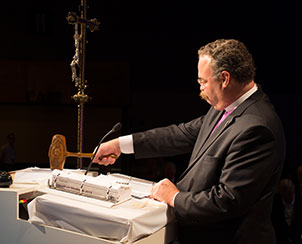 The gavel has sounded. The 2013 National LCMS Convention has come to a close. Some might call it “The Do-Nothing Convention.” Or “The Kick-the-Can-Down-the-Road Convention.” Or “The It-Isn’t-Time-Yet Convention.” Or “The Baptized-for-the-Next-Convention Convention.” But I think a better name might be “The Boring-Isn’t-Bad Convention.”
The gavel has sounded. The 2013 National LCMS Convention has come to a close. Some might call it “The Do-Nothing Convention.” Or “The Kick-the-Can-Down-the-Road Convention.” Or “The It-Isn’t-Time-Yet Convention.” Or “The Baptized-for-the-Next-Convention Convention.” But I think a better name might be “The Boring-Isn’t-Bad Convention.”
Late in the week President Harrison said (I’m paraphrasing, since I don’t have the exact quote in front of me): “Some have said this has been a boring convention. And that’s not bad.” My translation: There’s no way this convention could possibly match the intense drama of the 2010 convention. And a lot of the resolutions here won’t change the synod overnight and fix all the problems at once. But we are putting some things in place that will help us deal with the important issues, more directly and decisively, beginning at the next convention. We’re moving the ball down the field in the right direction. And we’re doing it in a patient, consensus-building way. In other words, boring isn’t bad.
Today I’m writing only a brief, off-the-top-of-my-head reflection on the convention just concluded. (I may put together a more complete report later on.) And I’ll focus on the business of the convention, the resolutions and elections, rather than on the worship, the theological essays, etc. For example, the magnificent music at the services, President Harrison’s “You’re all wet/It’s in the water” sermon, his “gavel-gazing” speech–all excellent, and you can find links to them through the lcms.org/convention page, but I won’t spend time on them here.
RESOLUTIONS
Of course many of the “mom and apple pie” resolutions passed by wide margins, virtually unopposed. These were opportunities to highlight the good work our synod has been doing in many areas: e.g., campus ministry, military chaplains, disaster response. So also with resolutions on the Koinonia Project, fellowship with several overseas church bodies, some boring bylaw language clarifications–little controversy there.
The resolutions that addressed more controverted issues fell mostly in these committees: 4, Theology and Church Relations; 5, Seminary and University Education; and 7, Structure and Ecclesiastical Matters.
Committees 4 and 5: In regard to licensed lay deacons and the SMP program, structures were put in place–a task force here, an oversight committee there–that will bring recommendations for action to the 2016 convention. Likewise with our seminaries and universities. There will be a task force to address the question of Lutheran identity at our Concordias, lest they drift away from our theological moorings. And there will be a committee that must give prior approval to any new faculty at our seminaries. These measures are not glamorous, but they could prove effective.
Committee 7: This committee did have some good resolutions, and they passed, particularly a couple that emphasize the importance of visitation. But this committee also proposed the only really bad resolutions in the book. These were the past Blue Ribbon proposals dug up from the graveyard of bad ideas. I am happy to report they all failed miserably. One resolution would have allowed visitation circuits to be formed by “affinity” rather than geography, thus further balkanizing us when we need to be brought together. We defeated that one on Monday by a whopping 71% to 29%. Another resolution, the worst one in the book, would have taken delegate elections away from the circuits and moved them up to the district level. We thermonucleared that one 93-7. Its companion enabling resolution thus did not come to the floor. And while the proposal to go to a four-year convention cycle was brought up early in the week, the committee did not bother bringing it back later, because that one would have been shot down too.
ELECTIONS
There were a total of 71 elections, if you include the pre-convention election for Synod President. And there were two competing lists recommending candidates. The United List (UL) traditionally recommends more conservative/confessional candidates. The other list usually recommends more liberal/church-growthish candidates. That list this time was called the “Missional/Our Future/Preferred Servants List” (MOFPSL)–the title morphed over the last several weeks. If you’re using a scorecard, the UL won 40 head-to-head elections, the MOFPSL won 19. Candidates common to both lists won eight elections, and candidates from neither list won four. Speaking as one who generally favors the United List choices, I can say we ran the table on the Praesidium, winning the presidency and all six vice-presidencies. This in turn may tip the balance–to the good–on the Council of Presidents. And we swept the four elections for new members to the Fort Wayne Board of Regents. But we split the four elections for the LCMS Board of Directors (although the overall balance looks good). And we split the four elections for the St. Louis BOR.
Overall, the tone of this convention was amicable, the theme for the inspiration was baptismal, the synod’s good work was highlighted, and the framework was put in place for correcting some nagging problems more decisively next time. All in all, boring isn’t bad. We’re moving in the right direction.